Easy Sourdough Bread (Whole Wheat-ish)
This post may contain affiliate links. Please read my disclosure policy.
This is my favorite sourdough bread: It’s high hydration, whole wheat(ish), and just so darn tasty. As far as sourdough recipes go, this is about as simple as it gets. Below, you’ll find video guidance for every step of the process. Let’s do this! 🍞🍞🍞🍞

Sourdough is often described as a journey. The more I make it, the more this sentiment becomes a truth. For the past few years, I’ve been tinkering with various sourdough recipes, and though I can’t say I won’t stop tinkering, this is the current snapshot of my sourdough journey.
These are the characteristics I like in a sourdough boule:
- high hydration (at least 75%)
- whole wheat-ish
- crusty but not super crusty
- nicely salted
- tangy though not super sour
I’ve outlined the process below to create this type of loaf, which as far as sourdough recipes go, is on the simple side — there’s no kneading, no autolyse-ing, no pre-fermenting, no levain-ing, no fancy scoring.
It’s a little bit smaller than most sourdough boules, too, reasons for which I explain below. And as with all sourdough baking (and bread baking in general), it does take time, though the time is mostly hands off.
This post is organized as follows:
- Two Sourdough Fermentation FAQs
- Two Tips for Assessing Fermentation
- Whole Wheat Flour
- Roller-Milled vs. Stone-Milled Flour
- 75% Hydration
- Mixing Sourdough Bread
- Bulk Fermentation
- Shaping + Bench Rest
- Proofing Sourdough
- Scoring and Baking Sourdough
- The Best Way to Store Bread
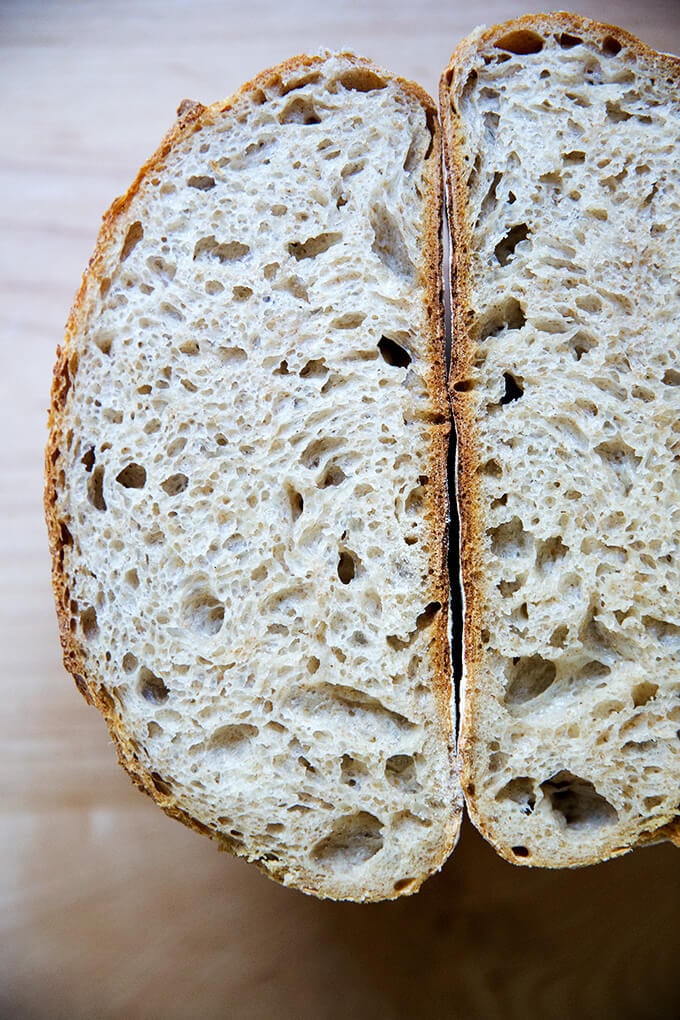
2 Sourdough Fermentation FAQs
Two of the most frequently asked questions I receive about sourdough bread baking are:
- How do I know when the dough has risen sufficiently and is therefore ready to be shaped?
- How do I know if it has proofed sufficiently and is therefore ready to be baked?
If you are unfamiliar with sourdough baking, these two questions relate to two distinct phases of fermentation:
- The first question relates to the bulk fermentation (the first rise), which takes place after the dough is mixed.
- The second question relates to proofing (the second rise), after the dough is shaped.
One thing I have learned through troubleshooting with various people is that it’s very hard to put a timeline on these two phases. Sourdough is much more sensitive than yeast-leavened breads to the environment in which it is being baked.
The bulk fermentation for me in my cold Upstate New York kitchen often takes 12 hours regardless of the time of year. For someone baking in humid Hawaii, it may take 6 hours (or less! or more!). Similarly, the proofing phase may vary by many hours depending on the environment. Additionally, there are countless variables that affect fermentation: type of flour, water, salt quantity, strength of the starter, to name a few.
Yes, there are textural/visual cues to help discern when each phase of fermentation is complete, but it still can be hard to judge.
If you struggle with these assessments, I have two tips for you:
2 Tips for Assessing Sourdough Fermentation
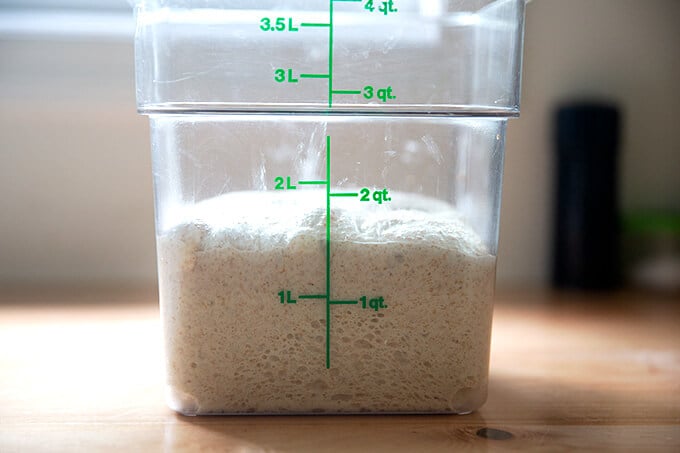
Tip #1: Buy a clear, straight-sided vessel.
After my digital scale, my clear, straight-sided 4-qt Cambro (**this one is BPA-free!**) has become my most important tool when it comes to sourdough bread baking. Why? For two reasons:
- Because it’s clear, it allows me to see when the dough is filled with bubbles and activity throughout — top, bottom, sides, etc.
- Because it’s straight sided, I know exactly when the dough has risen sufficiently (roughly 50% increase in volume) and is therefore ready to be shaped. When dough rises in a bowl, it’s very hard to gauge how much the dough has grown.
If I could single out the biggest lesson I’ve learned in my sourdough baking journey, it’s this: Do not allow sourdough rise beyond double during the bulk fermentation.
Why? When sourdoughs rise for too long, the dough weakens. A weak, fragile dough is hard to handle and difficult to shape into a tight round, which in turn makes for a dense loaf. Most recently I shoot to shape the dough when it has increased by 50% in volume.
Tip #2. Use Your Refrigerator & Be Flexible
Because judging bulk fermentation and proofing can be tricky, you can use your refrigerator during both phases.
Using your fridge for the bulk fermentation:
If, for instance, you see your dough rising nicely but all of a sudden it’s 10 pm and you’re ready for bed, and you know if you let the dough continue to rise, it will be way beyond double in the morning, stick the vessel in the fridge. The following morning, take it out and let the dough rise at room temperature until it has nearly doubled or, as I advise more and more, increased by 50% in volume.
With sourdough baking, you have to be patient, and you have to be flexible with the timing.
Using your fridge for proofing:
Using my fridge for the proofing phase has been the biggest change in my sourdough process of late. Previously, after shaping the boule and placing it in a towel-lined bowl, I would transfer the dough to the fridge for 1 hour, then bake it. These days, I like to stick the shaped boule in the fridge for at least 12 hours, but ideally 18-24 hours. Why?
- The extended cold proof creates a lighter, airier crumb.
- A cold round of dough is so much easier to handle from scoring it to transferring it to the Dutch oven.
Whole Wheat Flour FAQ

In my email course, Foolproof Bread Baking, I receive a lot of questions about how to incorporate more whole grain flours into bread.
This is a tricky one to answer for me for two reasons:
- I like white bread. A good loaf of bread for me has so much to do with texture. I love a pillowy, oily focaccia; a soft, squishy brioche bun; a ballooned, crisp-tender Neapolitan pizza. As soon as whole grain flour is entered into the mix, the texture changes, becoming heavier, denser.
- Commercial whole wheat flour isn’t necessarily healthier than commercial white flour. Wait, what? Read on.
Roller-milled Flour vs. Stone-milled Flour
Without getting too far into the weeds, most of the commercial flour on the market is made from wheat that has been roller milled, meaning a roller mill has separated the wheat kernel into three parts: the endosperm, germ, and bran. White flour is made from the endosperm.
Whole wheat flour, similarly, is made from rolled-milled wheat: again, first the kernel is separated into three parts: the endosperm, germ, and bran; BUT then the germ and the bran are added back in various proportions. Much research shows that as soon as the wheat kernel is separated into the various parts, much of the nutritional value is lost — even when the bran and germ are added in after the fact.
So what’s the solution?
Stone-Milled Flour
Stone-milled flour, contrary to roller-milled flour, is flour made from wheat that passes through a stone mill, the process of which keeps the endosperm, bran, and germ together. Much research shows that keeping the components together preserves the nutritional value.
The rub with stone-milled flour? Stone-milled flour is more perishable due to the presence of both the bran and the germ, but the germ in particular, which is packed with vitamins, minerals, and fats, which can go rancid quickly.
The boon? Because the bran and germ are present in the flour, it’s also more flavorful.
Anything else to consider? Baking with stone-milled flours requires a little more finesse. Even a small amount of bran and germ in the mix makes for a denser loaf. Many millers offer high-extraction stone-milled flours — meaning stone-milled flours that have been sifted to remove some of the bran and endosperm. But even when you bake with high-extraction, stone-milled flour, the finished loaf, when made from 100% of this type of flour, will be very dense.
For this reason, I use at the most 25% stone-milled flour (100 g for this recipe), but preferably in terms of texture, 12.5% stone-milled flour (50 g for this recipe). 12.5% may seem like a tiny amount, but I am constantly surprised by how much flavor, texture, and color this small proportion of stone-milled flour offers to a loaf of bread.
In fact, I now prefer a partially whole wheat loaf to an all white loaf. The freshly milled, stone-milled flours offer so much flavor.
Where to Buy Stone-Milled Flour?
In the past few years, it has become easier to find stone-milled flour, and if you are up for it, you should seek out locally, stone-milled flour. Why? Because if you’re buying locally milled flour, you likely can find out how recently it was milled. Because stone-milled flour perishes more quickly than roller-milled flour, it’s best if you can find a local source, which will ensure it will be fresh. Note: Store stone-milled flour in the freezer if you don’t bake regularly.
Final note: I no longer buy commercial whole wheat flours. I buy commercial white flours: King Arthur Flour’s all-purpose flour and bread flour are staples. I find locally milled stone-milled flours at a local co-op, Honest Weight Food Co-op, and I also order online from various sources. Here are a few I love:
Finally: Here’s a great resource if you’re interested in learning more about wheat and flour: The Bread Lab. Also, Dan Barber’s The Third Plate was eye opening.

75% Hydration
Standard sourdough recipes often call for 500g of flour per loaf. As noted above, the recipe below makes a loaf that’s a little bit smaller for two reasons:
- I’m often asked if the bread recipes here on the blog as well as in my book can be halved. The answer is yes, but in an effort to make a loaf that may not feel quite so overwhelming for people, I’ve reduced the flour to 400g.
- I wanted to include quantities that make hydration easier to understand. Hydration is something I don’t discuss too often because I find it can turn people off (me included). In short, hydration is: the ratio of water relative to flour in a bread dough. The proportions in this recipe — 300g water and 400g flour — make it a little easier to see it’s a 75% hydration dough: 300/400=0.75.* With this baseline, you can increase the amount of water to make it higher hydration or decrease the amount of water to make it lower hydration depending on your preference.
*Note: This is a crude calculation. If you want to be super accurate when calculating hydration, you include the weight of the starter in the equation, too, which will throw off the percentage slightly.
Salt
I love salt. The standard percentage of salt in a bread recipe is 2% by weight of the flour. For 400g flour, this means 8g salt. I use 10g. The amount of salt, fortunately, is a variable that can easily be tailored to your liking. If 10g of salt is too much for you or if you know from the start you are sensitive to salt, start with 8g, then adjust accordingly. Also, higher amounts of salt will slow down the rise a bit as well.
5 Phases: Simple Sourdough Bread
This videos and photos below shows how to make from start to finish the high-hydration, whole wheat(-ish) sourdough bread recipe included at the end of the post.
Phase 1: Mix the Dough
Step 1: Gather your ingredients — flour, salt, water, a sourdough starter — and equipment, namely a digital scale. I recommend buying a starter (reasons for which I explain here). But if you’re up for it, you can make a sourdough starter from scratch in just about a week. I only recommend doing so if it currently is summer (or a very warm fall) where you are.

Most important, you need a fed, active starter.

To ensure it is ready, drop a spoonful of it in a glass of water. If it floats, it’s ready:
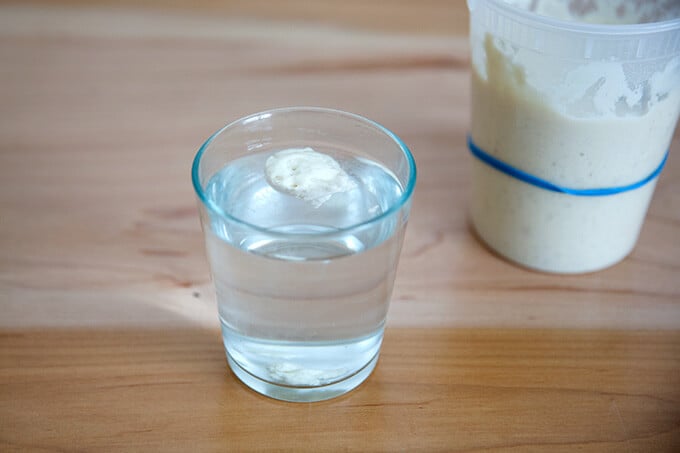
Start by weighing 300g water, 100g starter, and 10g salt.
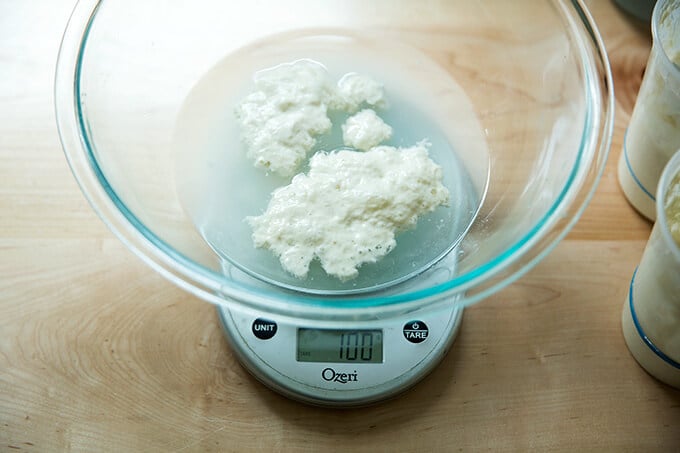
You’ll need 400g flour. You can use all bread flour of a mix of bread flour and whole wheat flour. My preferences is 350g bread flour (King Arthur Flour) and 50g stone-milled, freshly milled flour (I use a mix of Anson Mills rye and graham).

Mix to form a sticky dough ball.
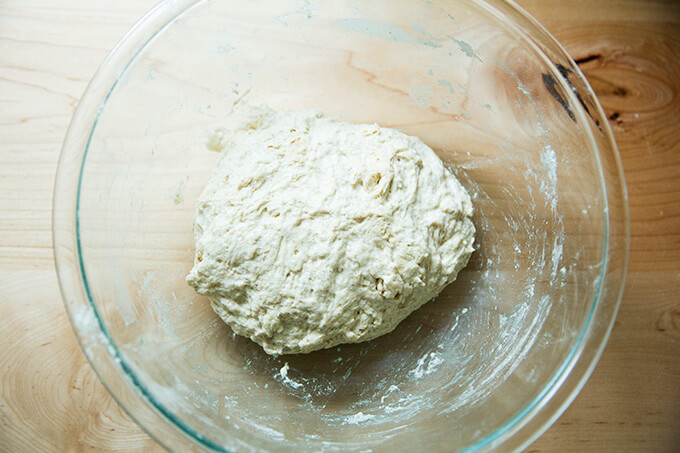
Then transfer to a straight-sided vessel for the bulk fermentation (the first rise).
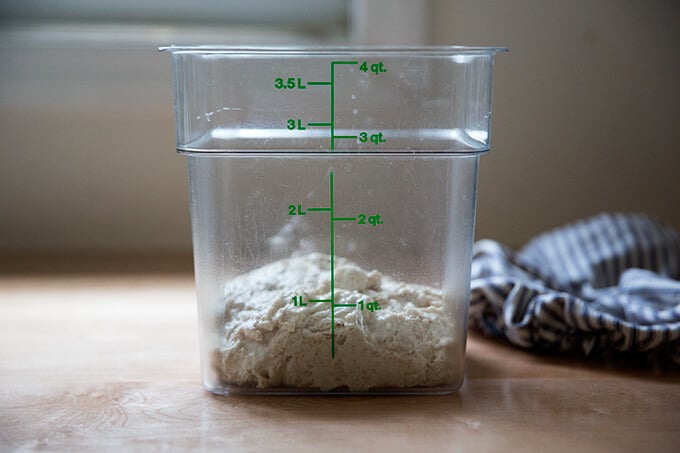
Phase 2: Bulk Fermentation
After 30 minutes, stretch and fold the dough:
You’ll repeat this stretching and folding 3x at 30-minute intervals; then you’ll leave the dough to rise until it increases in volume by 50-75%.
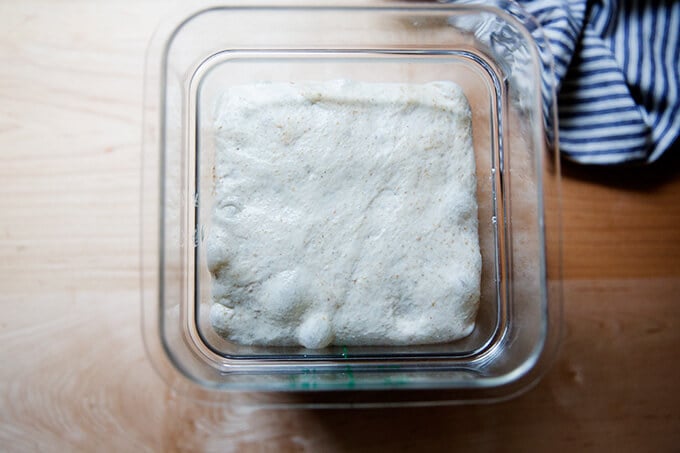

Phase 3: Shape + Bench Rest
Transfer dough to a clean work surface. I prefer to use no flour and minimal handling to shape it into a ball.
After the initial shape, let the dough rest for 20-40 minutes; then shape again and transfer to a flour sack-lined bowl.
Phase 4: Proof
Transfer bowl to fridge to proof (second rise) for 18 to 24 hours
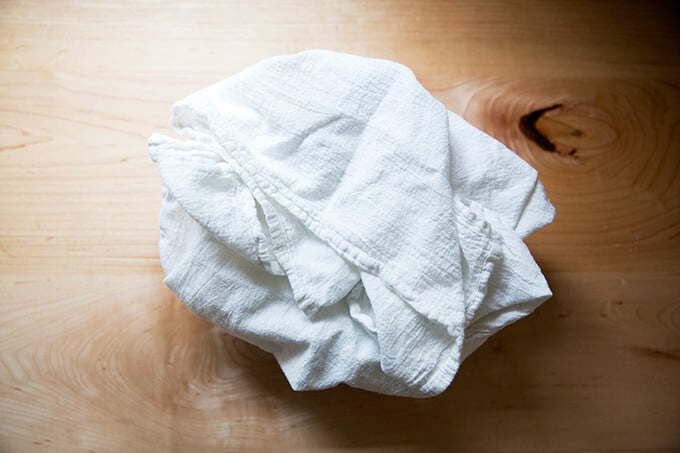

Phase 5: Score + Bake
After 18 to 24 hours, transfer dough to a sheet of parchment paper. This video shows how:
Score as you wish; simple is fine.
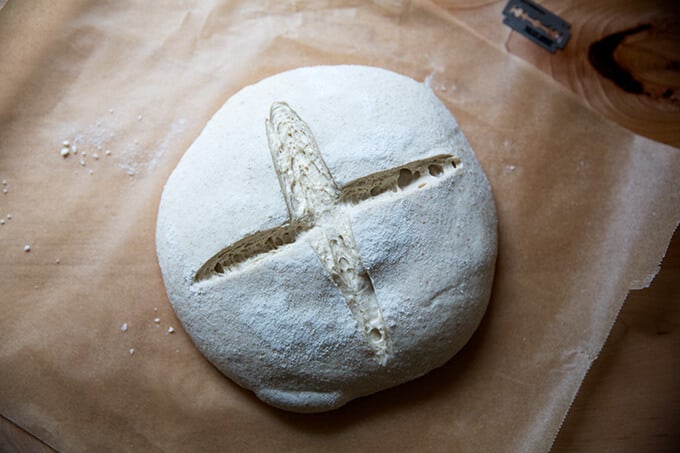
Transfer to a Dutch oven and bake at 450ºF covered for 30 minutes, then uncovered for 10 minutes at 400ºF.
The Best Way to Store Bread
How do I store bread? is one of the most frequently asked questions I receive.
If you want to store the bread at room temperature for 3 to 4 days, I think the best method is in a ziplock bag. I’ve tried other reusable/environmentally friendly options, but nothing seems to keep bread freshest — the crumb the softest — better than a ziplock bag.
If you intend to keep the bread for longer, I would stick the ziplock bag in the freezer, and pull out slices or hunks as you wish. I often slice bread as soon as it cools completely, transfer the slices to a ziplock bag, then freeze. This way, I know the bread was frozen at its freshest.
A ziplock bag will not prevent the crust of bread from turning soft, which is why I suggest always reheating day-old bread. I use a toaster at breakfast for slices of bread, and I reheat half or quarter loaves in the oven at 350ºF for 15 to 20 minutes when serving for dinner.
Bread revives so beautifully in the oven or toaster.

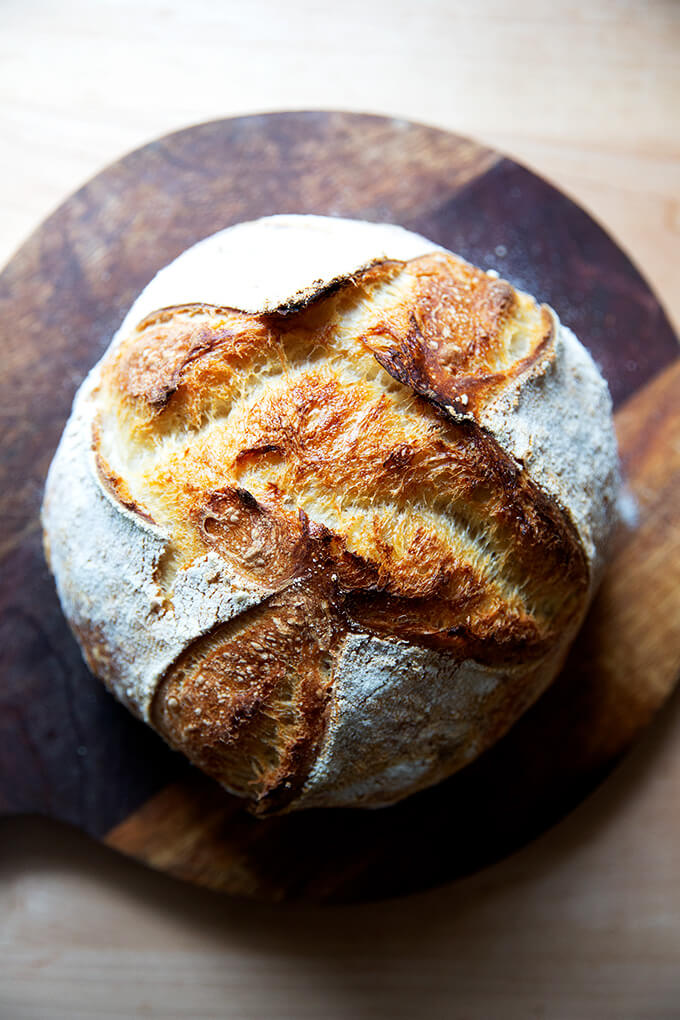

I baked this loaf in a tall-sided pullman loaf. Love the shape! I proofed this in the fridge for about 12 hours; then let rise at room temperature for roughly 5-6 hours before baking at 400ºF for about 40 minutes.


Easy Sourdough Bread (Whole Wheat-ish)
- Total Time: 48 hours 45 minutes
- Yield: 1 loaf
Description
Special equipment: Straight-sided vessel for the bulk fermentation, Dutch oven, flour-sack towel
Here’s my list of essentials for sourdough bread baking.
Digital Scale: Do not attempt this recipe without a scale. This one costs $9. Troubleshooting what goes wrong with sourdough bread is impossible if you’ve measured with cups. They’re simply not accurate.
Troubleshooting: If you have issues with your dough being too sticky, please read this post: Why is my sourdough so sticky? The 4 common mistakes.
Flour:
- I prefer making this bread with 350g bread flour and 50g of freshly milled, stone-milled flour, which provides both flavor and color. (Read the post above for more details and why I suggest stone-milled flour as opposed to commercial whole wheat flour.) I’ve been using a mix of Anson Mills graham flour and rye flour, but there are many great stone-milled flours out there, and you may have a local source, which is even better.
- 50g may seem like a tiny amount of stone-milled flour for this recipe, but I am constantly amazed by how much flavor this small amount of freshly milled flour adds. If you are new to sourdough baking, I recommend starting with 100% bread flour (King Arthur Flour is my preference) because it’s so forgiving and easy to work with. Once you get the hang of it, start incorporating stone-milled flour a little bit at a time. I don’t like using more than 100g (25%) of stone-milled flour in this recipe.
- If you cannot find bread flour — I know supplies are limited at the moment — you can use all-purpose flour. If you live in a humid climate, consider reducing the water by 20 g. You can add the 20 g of water in slowly while you mix until the dough resembles that in the video/photos.
Salt:
I like breads to be a little bit saltier than standard. If you are sensitive to salt, start with 8g. Next time, adjust salt as you wish.
Ingredients
*Please read notes above before proceeding. Watching the video is helpful, too.*
- 400 g bread flour, see notes above
- 8g to 10g kosher salt or sea salt, see notes above
- 300 g water
- 100 g active sourdough starter
- rice flour, for dusting
Instructions
- Mix the dough. In a large bowl, combine the water, starter, and salt. Stir with a rubber spatula to loosely combine. Add the flour, and stir with a spatula to combine — it will be a wet, sticky dough ball. Transfer to a straight-sided vessel and cover with a tea towel or bowl cover for 30 minutes.
- Stretch and fold. After 30 minutes, grab a corner of the dough and pull it up and into the center. Repeat until you’ve performed this series of folds 4 to 5 times with the dough. Let dough rest for another 30 minutes and repeat the stretching and folding action. If you have the time: do this twice more for a total of 4 times in 2 hours. [Video guidance here.] Note: Even if you can only perform one series of stretches and folds, your dough will benefit. So don’t worry if you have to run off shortly after you mix the dough.
- Bulk fermentation: Cover the vessel with a tea towel or bowl cover and let rise at room temperature (70ºF/21ºC) for 4 to 18 hours (times will vary based on the time of year, the humidity, and the temperature of your kitchen). The bulk fermentation will end when the dough has nearly doubled in volume and you can see bubbles throughout the dough and on the surface. (Note: Do not use your oven with the light on for the bulk fermentation — it is too warm for the dough. To determine when the bulk fermentation is done, it is best to rely on visual cues (doubling in volume) as opposed to time. A straight-sided vessel makes monitoring the bulk fermentation especially easy because it allows you to see when your dough has truly doubled.)
- Shape: Gently transfer the dough to clean work surface. I prefer to use no flour and a bench scraper at this step, but if you find an un-floured work surface to be difficult, feel free to lightly flour it. [Video guidance is especially helpful for this step.] Fold the dough, envelope style: top third over to the center; bottom third up and over to the center. Then repeat from right to left. Turn the dough over and use your bench scraper to push the dough up, then back towards you to create a tight ball. Repeat this pushing and pulling till you feel you have some tension in your ball. Place the dough ball top side down and let rest 30 to 40 minutes. (FYI: This is called the bench rest.)
- Proof. Line a shallow 2-qt bowl (or something similar) with a tea towel or flour sack towel. Flour sack towels are amazing because the dough doesn’t stick to them, and therefore you need very little rice flour, but if you only have a tea towel, you will be fine. If you are using a tea towel, sprinkle it generously with rice flour. If you are using a flour sack towel, you can use a lighter hand with the rice flour. After the 30-to 40-minute bench rest, repeat the envelope-style folding and the bench scraper pushing and pulling till you have a tight ball. [Video guidance here.] Place the ball top side down in your prepared towel-lined bowl. Cover bowl with overhanging towel. Transfer bowl to the fridge for 12 to 24 hours. (Note: When you remove your dough from the fridge, visually it will likely look unchanged. This is OK. You do not need to let it then proof at room temperature before baking.)
- Bake. Heat oven to 500ºF. Remove your sourdough from the fridge. Open the towel. Place a sheet of parchment over the bowl. Place a plate over the parchment. With a hand firmly on the plate and one on the bowl, turn the dough out onto the parchment-paper lined plate. [Video guidance here.] Carefully remove the bowl and towel. Carefully remove the plate. Brush off any excess rice flour. Use a razor blade to score the dough as you wish. I always do a simple X. Grab the ends of the parchment paper and transfer to the Dutch oven. [Video guidance here.] Cover it. Lower oven temperature to 450ºF, bake covered for 30 minutes. Uncover. Lower temperature to 400ºF. Bake for 10 minutes more or until the loaf has darkened to your liking. Transfer loaf to a cooling rack.
- Cool. Let loaf cool for at least 30 minutes before cutting.
- Prep Time: 48 hours
- Cook Time: 45 minutes
- Category: Bread
- Method: Sourdough
- Cuisine: Global
This post may contain affiliate links. Please read my disclosure policy.











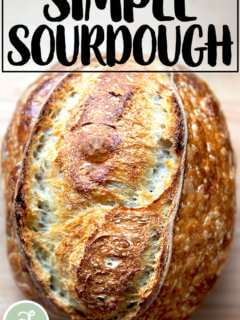
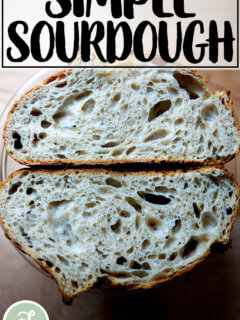
985 Comments on “Easy Sourdough Bread (Whole Wheat-ish)”
I tried not preheating the pan, and was disappointed with the results. The crust is tough and rubbery, not crisp. The inside is a bit damp.
Oh bummer! I’m sorry to hear this. I just removed that note from the directions … I always preheat and prefer preheating but some people have trouble handling the hot pot, which is why included that note. I honestly had forgotten that that note was still in there … totally my bad. So sorry your loaf didn’t bake up well.
Hi Alexandra!
Thank you so much for sharing your recipe – I am brand new to bread baking, and I feel really lucky to have found your page! After just 1-2 attempts, I’m now making a loaf weekly to use for lunches, and it’s such a great feeling 🙂
I had a quick question – is there any guidance on baking times if you make larger or smaller loaves? E.g., if I make a loaf that is half as big, does that decrease the baking same by the same proportion? Was hoping to do this to be able to bake multiple to share with friends.
Thanks again for all your great insights!
Hillary
Great to hear all of this, Hillary! The baking time will be shorter but not cut in half. Try baking the loaf covered for 20 minutes, then uncovered for 15 minutes or until it is browned to your liking.
Hello! I had my first take on this recipe and, despite some mistakes, it still gave a pretty good result. I have some questions, if possible. If I use my fridge during bulk fermentation, how do I proceed afterwards? Do I go straight to the shaping part or do I wait for the dough to come to room temperature? Also, if I want to bake this in a tin loaf do I shape into the tin loaf and then put it in the fridge for proofing? Do I bake immediately afterwards? Thank you for this wonderful, flexible recipe and I hope my questions are not too silly!
Hi Maria! No such thing as a silly question 🙂 Answers are below.
how do I proceed afterwards? Do I go straight to the shaping part or do I wait for the dough to come to room temperature?
If the dough has doubled in volume or nearly doubled while it’s in the fridge or before it entered the fridge, you don’t need to let the dough come to room temperature. Move on with the next steps. If the dough still needs to complete the bulk fermentation, let it hang out at room temperature until it does.
Also, if I want to bake this in a tin loaf do I shape into the tin loaf and then put it in the fridge for proofing? Do I bake immediately afterwards?
If using a tin, shape the loaf and place it in the tin. Transfer the entire pan to a large ziplock bag or produce bag or something that will prevent the dough from drying out. And yes, transfer it to the fridge immediately. When you are ready to bake, if the dough has started to crown the rim of the pan, you can bake it immediately. If it has not, let it sit at room temperature until it crowns the rim of the pan.
Let me know if this all makes sense 🙂
It did make sense, this was the first time my kids liked and actually ate a loaf I made – that’s a huge success! This time I baked it in a Dutch oven, I guess the oven temperature would change if I were to bake it in a tin? Also, it’s getting really hot where I live (around 95 degrees). Do you recommend using cold water to help prolong the bulk fermentation process? Again, thank you for this recipe – it’s the only one that has worked for me!
Great to hear! For a tin, I would do this: Heat oven to 425ºF. Transfer pan to the oven and bake for about 20 minutes. Reduce heat to 375ºF. Bake for 20 to 25 minutes more or until golden all around.
Cold water is a great idea in the summer 🙂
Hi! I just stumbled upon Mark Bittman’s Whole Wheat No-Knead bread that allows for substituting sourdough starter for yeast – resulting (obviously) in Whole Wheat sourdough. Has anyone tried it? It just seems almost too simple lol.
Great recipe!
Great to hear, Kat! Thanks so much for writing 🙂 🙂 🙂
This is recipe is outstanding. First time trying sourdough with some whole grain flour. The crust and crumb are perfection.
Thanks for sharing.
So great to hear this, Calvin! Thanks so much for writing and sharing 🙂 🙂 🙂
Hi Ali !
We love your sourdough bread recipes. I would say the sourdough focaccia and the sandwich bread are our favorites. I want to try making a cracked wheat sourdough similar to the one at Trader Joes. I’ve made your bulgar bread from BTC and was thinking of incorporating bulgar into this recipe. Do you have any suggestions on if that might work?
My family thanks you for all the fabulous recipes! 😊
Hi Lisa! Great to hear all of this… thank you 🙂 🙂 🙂 Regarding adding bulgur, I might consider cooking 1/2 cup of dried bulgur, letting it cool, and drain. Once cool, I think you could incorporate the cooked bulgur into the dough after one or two sets of stretches and folds. I don’t think you need to change the water level because this is pretty high hydration as it is. Let me know if you give it a go! My only other thought is that 1/2 cup of dried bulgur might yield too much cooked bulgur… I just don’t want your bread to be dense. So use your judgement about how much of the cooked bulgur to incorporate.
I read the book and really did change my life! I was browsing around Anson Mills and found Bread Lab too. I will definitely try their flour. I’m not a baker at all but I bet it’s hard to ruin the bread!
LOVED the recipe. Great tasting bread. It’s the first time that I did the final rise in the fridge overnight.
I used about 20g of rye and 30g of whole wheat flour in addition to the bread flour. The only problem I have that the inside is very soft (maybe even a bit “damp?”) and the bread is difficult to cut. Should I slightly reduce the amount of water?
Hi Christiane! Yeah, it sounds as though you may need to reduce the water slightly. Try holding back 50 to 75 grams.
Thank you for your reply. I will give that a try.
Since making this bread, I baked a sourdough rye bread which I have made multiple times in the past. Since leaving the dough in the fridge overnight is so convenient, I also did the final rise in the fridge which I hadn’t done before. And while the bread had a nice height and even interior, it is also difficult to cut. So now I’m wondering if it has something to do with leaving the dough in the fridge. Any thoughts?
Hi! When you do the fridge rise, are you covering the dough? I always have the dough wrapped in a flour sack towel, which protects it, but if the dough is developing a crust in the fridge, you should tuck the whole thing in a plastic bag — plastic produce bags work great.
What do I do if I don’t want to put it in the fridge? Can I go from bench rest straight to bake?
You’ll need to do a room temperature proof for about 4 to 6 hours, depending on the temperature of your kitchen. I would keep the loaf covered — like in a produce bag loosely tied — and check on it periodically. When you press on the dough lightly, it should spring back slowly.
I’ve made this recipe multiple times and it’s been amazing… but this time it proofed longer than usual… and when I put in the baking pan… it was not poofy… kinda flat… baked it … very flat. Is my starter no good?proofed it too long? Bulk fermentation was a bit longer too… that an issue?
Hi Tuula, It could have been any of those issues, starting with either a weak starter or a too-long bulk fermentation. I would check out this troubleshooting post to pinpoint where things might have gone wrong.
This is more of a question. On Wednesday I mixed my bubbly starter with the right proportions of water, flour, and salt, completed a bunch of folds. I ran out of time and stored it in the fridge. I’ve noticed that the dough has already almost doubled in the fridge. I think my bulk fermentation is pretty much done. I won’t have time to bake it until Sunday.
So, now what? Should I let the dough come to room temp today, complete any more bulk fermentation outside the fridge, then shape the dough and let it proof for more than 24 hours?
Or, leave the dough in the fridge for another day and then let the dough come to room temp, shape it, and then proof it, so the proof time is shorter?
Hi Andrea,
I am likely too late here, but I would have either removed the dough and shaped it (no need to bring it to room temp) and returned it to the fridge or I would have left it in the fridge until I had time to shape it.
What temp is your fridge?
After shaping, can you cold proof for longer than 24 hours or does that create issues?
Yep! 48 hours is about how long I push it.
Thanks for the reply! I ended up letting it cold proof for around 30 hours and it baked up beautifully. For my next boule I am interested in adding poppyseeds and hemp heart seeds. Do you think I could get away with keeping the water/starter ratio the same, or would you suggest adding more or less to account for thirsty seeds? I’ve only ever followed your sourdough recipes and haven’t done any inclusion loaves yet, so I’m curious what you would recommend for ratios. Thanks so much!
Hi Deanna! Great to read all of this. I might try increasing the water by 5 to 10 grams. It’s pretty high hydration as it is, so I’d hate for you to increase it so much that it becomes unmanageable. It’s possible you could get away with not increasing the water at all. Good luck!
So, I ended up adding an extra 3 grams of water to the recipe for my seeded version, plus around 2tbsp hemp hearts, 2tbsp poppyseeds. The loaf tasted awesome but didn’t bake as tall as the one I baked previously without seeds. I think it was just too much water? I did everything else the same. So I’m attempting a seeded version of this recipe again tonight only this time I’m not adding more water. Hopefully it bakes up taller than the last one.
OK, interesting, Deanna! Initially I thought it might just be too many seeds, but 1/4 cup of seeds does not seem like too many. And 3 grams of water does not seem as though it would affect the dough either. I will be curious to hear how the next batch goes. Good luck! Thanks for reporting back.
Question: I know you state not to use the oven with the light for the bulk fermentation, but how about using a Brod and Taylor proofer set to 75 degrees? I am in Minnesota, and in the winter, we keep our house at 63 degrees to hold down heating costs.
Absolutely: go for it! I think 75-78ºF is perfect. The oven light will get the oven to about 100ºF or even hotter, which can be too hot.
I did not see your reply before I used your recipe, and I went ahead and did use the proofer. Turned out fantastic! As mentioned in another post, I will be using this recipe from now on. Also as per your suggestions, I am looking forward to using some local stone ground flour. Found a place not too far from me where I can order online and pick up in person! Finally, I have used your sourdough pizza crust for the past couple years, and it has spoiled everyone in my family; simply the best! Thanks so much.
So nice to read all of this, Mark! I have seriously considered buying a Brod and Taylor proofer over the years given that my kitchen is so cold for most of the year (Upstate New York), and your comment is encouraging me to really go for it. Great to hear about having a source for local flour and, of course, about the pizza 🙂 Thanks so much for writing!
The Brod and Taylor is a good call; especially when it is minus 20 here in Minnesota! Quick story that prompted me to get the proofer. Earlier this winter, I needed to start a new batch of sour dough starter, and I was using our oven with the light on to keep it warm (roughly 80 degrees). I was on the last day of a 7 day routine to get the starter up to speed when my wife forgot I had it in the oven and preheated it for some meal she was making. Well, that killed the starter and I bought the Brod and Taylor-and no more worries about a really frigid kitchen messing with my baked goods! Take car.
Oh, I have so done that with bread keeping cozy in a draft-free spot … it’s crushing! But especially crushing with a homemade sourdough starter, which is no easy task. I’m on day 14 of a homemade starter, and only just this morning, I saw some rise — it was thrilling! With that in mind, do you have tips regarding your 7-day routine? I have been trying to get a homemade starter recipe up on this blog for years, but I have never been able to make one in under 2 weeks, which has convinced me that buying one is the way to go for ease and simplicity. If you have time to share, I’d love to hear your thoughts. Thank you!
Regarding a 7 day starter, I used a recipe from another website that would have worked had my wife not inadvertently sentenced it to death. I am unsure what your protocol is for posting another source here, so for now I will refrain from doing so. That said, I have no doubt that the starter recipe I used would easily come to life in the Brod and Taylor proofer in 7 days, but I went ahead and purchased a starter from King Arthur as I had in the past.
Oh I’d love to hear about whatever site you are using — I always give credit if I use another website or book. Thank you! Smart re purchasing a starter 🙂 🙂 🙂
The site is called The Perfect Loaf (and it is a great, informative site!), and there is a page dedicated to making a starter from scratch. https://www.theperfectloaf.com/7-easy-steps-making-incredible-sourdough-starter-scratch/#tasty-recipes-10771-jump-target
Oh I love Maurizio! I made his English muffins from his new book recently. Thanks for sharing. Incidentally, I started a new starter using pineapple juice yesterday, but I will check out Maurizio’s post as well. He has some great info in his book as well. Thanks so much for sending!
Easy to get lost in the weeds in his site-and that is not a complaint!
Absolutely! Been there 🙂 🙂 🙂
So much easier than messing around with a levain! I used a Brod and Taylor proofer (set at 72) to keep the dough in until putting in in the fridge for about 18 hours, and it turned out perfect. I also really appreciate that this recipe makes one loaf.
What a brilliant recipe! I can’t thank you enough for making my first loaf of sourdough such a success. Tonight, I did my second and third lofa, and I notice it’s perfect BUT it’s not a crispy tan/brown color. Is it due to the flour I am using or do I need to keep it in the oven longer? I did 30 minutes in covered dutch and another 21 minutes uncovered.
Great to hear, Meredith!
What type of flour are you using? It could definitely be the flour; it could also be the timing.
This recipe was amazing! So easy to follow and produced such a beautiful crumb. Do you have an suggestions on how to keep the bottom from browsing too much? I’ve tried the sheet pan on a lower rack and just can’t seem to fix this issue.
Great to hear! Here are a few thoughts you can find in this post moving forward: Why is my sourdough so sticky? 4 Common Sourdough Mistakes + Answers to FAQ’s
If you are using a preheated Dutch oven, consider lowering the temperature.
Before you make changes to the temperature, however, next time you bake, check the dough after 30 minutes. If the dough is browning too much on the bottom, you know that it’s happening during these first 30 minutes, in which case, you should lower the temperature from the start. Decrease it by 25ºF.
If the dough is not browning, then you know the burning is happening during the last 15-20 minutes of baking, in which case you could remove the loaf from the pot after 30 minutes and bake it on a sheet pan.
Another option: place your Dutch oven on two sheet pans. I do this with challah to prevent the bottom from burning. The extra layer of sheet pans will prevent the bottom of your sourdough from burning, too.
Another option: place your Dutch oven on a broiling pan.
Finally: Use rice flour for dusting — it makes all the difference. It does not burn the way wheat flour does. It also doesn’t coat the loaves with an unpleasant raw flour taste. One bag will last you a long time.
I have been baking bread for decades and have developed lots of “secrets” over the years. But sourdough has been my nemesis. I have tried so many different methods and have achieved a decent sourdough loaf. But a consistent, nicely shaped, tangy loaf with those great sourdough holes has evaded me. Until now! My daughter gave me a loaf of this sourdough bread Ali, and it was one of the best I have ever had! The first time I made it, it turned out great. But I was wondering is it a “one-off” experience? Second, third, fourth, fifth, and subsequent loaves fantastic too! Bread baking is art/science combo with variables so that even the most “perfected” recipe can keep you guessing until you actually cut the loaf. This recipe yields a consistent and repeatable outcome, environmental variables notwithstanding. The flavor is phenomenal. Beautiful varied crumb with a spectacular chewy crust!
After experimenting a bit my personal preference is to forego the dutch oven and bake directly on my oven bricks with steam including several additional blasts of steam the first five minutes or so. And when I’m in the mood for a super tangly loaf I’ll go with a super active starter and adjust to 150g starter and back the water off to 275g.
BUT – your recipe stands on it own and is wonderful just as is! Thank you for sharing this fantastic recipe with us.
Ezekiel, it’s so wonderful to read all of this. Thank you so much for writing and sharing your notes regarding the bricks, steam, and more starter. I’m dying to try making a loaf in my outdoor pizza oven (a gozney dome), which has a way to add steam… haven’t figured that out yet, but I imagine it’s simple. Thanks for the inspiration!
Super Newbie here, as in only one sourdough under my belt. Can I use this recipe with just unbleached all purpose? Or all purpose/rye mix? I like the ease I feel following this recipe and would love to try it! Lol.
Yes! I definitely recommend if you are a newbie using all bread flour or all all-purpose flour or the suggested 350 g ap/bread flour and 50 g rye or other whole wheat/stone-milled flour.
Hello from Canada. I’m a newbie to baking and want to learn how to bake sourdough bread. How cold should the fridge be for the bulk fermentation and proofing?
Hi! I’d say 37-40ºF is about right.
I just over proofed my dough. I let it rise in the greenhouse and it had tripled in size. I would have been better off indoors with it. I wonder if my bread rises quickly and I am using 100 g of starter, is it better to decrease the amount of starter or decrease the amoiunt of time I wait for it to rise? By the way, I love your recipes!
Thank you,
Linda
Hi Linda! I think using 50 grams of flour might be a good idea to slow down the rise. Good things happen in the dough with a longer, slower rise.
But, you could also experiment: do one batch with 50 grams starter; do another with a shorter rise. If you still do the long, cold proof, you’ll probably get very similar results.
Thank you for your kind words 🙂
Ali’s recipe and her process instructions creates fantastic sourdough bread loaf’s! I have been baking sourdough for 10 years and have tried various recipes and methods. By far Ali’s recipe is lightest texture with a strong crust. I used Cairnspring whole wheat flour and King Arther organic all purpose flour mixed as recommended.
Great to hear, Susan! And yay for using Cairnspring flour! Love their flours so much.
Really lovely thanks for the great instructions
Great to hear Elizabeth 🙂
I started to post a comment here but hit the wrong button…and it is lost! I came back to be sure I left a 100-star rating, but it only goes 5-star! Thanks for all your great recipes, especially your bread!💜
Thank you, Priscilla 🙂 🙂 🙂 So nice to read all of this.
I started with you recipe and have been experimenting – I’m looking to get to about 2/3 whole wheat to 1/3 bread flour. Today I did a 50/50 – 100 grams spelt, 100 grams einkorn, and 200 grams KA bread – I also use the Emile Henry bread pan (the clay one) – wow! Beautiful and delicious.
So nice to read this Victoria! Thanks for writing and sharing your notes 🙂
I have used this recipe for a couple of years now, and it is THE BEST. I can’t even count how many friends have eaten my bread and asked for me to forward this recipe. So many!
I loved all the pictures and videos which allowed me to really understand how to do each step. Now, I don’t even have to think about it, and it takes so little effort to make an amazing loaf of sourdough. I would love to learn how to make sourdough dinner rolls, but I don’t see any recipes that make sense to me. Ali, I’d love to get your take on a sourdough dinner roll recipe! (I would imagine it’s the same recipe, but with different gear for baking…?)
Thank you so much for all of this, Ali 🙂 🙂 🙂 It’s so nice to read.
I DO need to get a sourdough dinner roll recipe up here. I will get on it. And yes: I think I would basically do the same, but shape the rolls after the bulk fermentation and nestle them in a 9×13-inch pan or two 8-inch pans or something of the like… stay tuned!
Can I proof it in a 9″ banneton or is that too big?
It might be slightly too big, which could contribute to a flatter loaf, but the texture and flavor will be the same.
I tried this recipe with 50 grams of freshly ground wheat. Should I count on the 50 grams of whole wheat making it not rise as much as an all white loaf? It rose some, but not as much as all white. And should I count on a longer bake time? It ended up with the tunneling. I read that tunneling is a sign of underproofing. I did the 2nd rise or proof in the refrigerator for 24 hours. Is it still possible for sourdough to be underproofed even after 24 hours in the fridge? Thank you!
Hi! 50 grams will affect the rise somewhat, but you should still be able to get a nice, lofty loaf. Regarding the tunneling, how long was the bulk fermentation? and how much did the dough increase in volume? Did the shaping step go OK? Did your dough feel strong?
I’m not sure how many hours for the Bulk fermentation bc it’s very cold here. So it was most of the day. I would say it doubled. The shaping went good and the dough felt strong to me. I followed the times on the baking and added 5 or 10 minutes, but wondered if I still underbaked it. It temped correctly at 205-210. I made 2 loaves. The loaf in the loaf pan didn’t have the tunneling, but the one I baked in the Dutch oven did have the tunneling.
That’s interesting! It does make me think the dough was slightly underproofed, but 24 hours in the fridge is definitely sufficient. I’m sort of stumped here. If your dough doubled during the bulk fermentation, and you gave it sufficient time to cold proof… I dunno! My only thought would be to give it some time at room temperature before baking it next time around — let it rise for an hour or two before baking.
hi! I’m new to sourdough so learning as much as I can… I have a few questions as what you do seems to be different to the “normal”? Please note I’m just trying to understand, not question!
1. incorporate salt immediately – doesn’t that slow down fermentation?
2. you seem to only do 3 stretch and folds, without any kneading or slap & fold at the beginning. Interested in how this results in strong enough dough?
3. you also don’t incorporate an autolyse phase?
many thanks! David
Hi David! Your great questions are answered below.
1. Incorporate salt immediately – doesn’t that slow down fermentation?
I don’t find it does.
2. you seem to only do 3 stretch and folds, without any kneading or slap & fold at the beginning. Interested in how this results in strong enough dough?
I find the stretches and folds strengthen the dough beautifully. I do 4 sets of stretches and folds. (I’ll double check the recipe, but that is my intention.)
3. You also don’t incorporate an autolyse phase?
No autolyse! I just don’t find it to be necessary especially when using mostly bread or ap flour, which are strong flours. I think an autolyse is especially helpful when using a higher percentage of freshly milled or whole wheat flour, where there is a lot more bran present, which cuts through the gluten-structure. The autolyse step can provide strength to these sorts of doughs.
Here, however, when I am using 25% freshly milled flour at the most, it’s just not necessary. I’ve never loved the process of an autolylse — I find it really hard to incorporate salt and more water/flour to the autolysed dough, and so I avoid the step if possible.
I’d suggest making this recipe once and evaluate how you like it. Then make it with an autolyse and see if you notice any difference.
I waited over 18 hours for the bulk fermentation and my bread did not rise at all. there was a bubble but I think with it sitting out, it formed a bit of a crust on top so I am wondering if that contributed to it not rising? The starter was peaked and was floating on the top of the water when I started so I don’t think that was the issue… It’s in the oven now and I’m hoping for the best! haha
Update:
It’s a bit dense and gummy compared to soft and fluffy. Not sure where I went wrong, i did notice my dough was slightly less hydrated than the one in the video looked but hopefully I’ll have better luck next time!
OK, thanks for the update.
Are you using a scale to measure? What type of flour are you using? Are you new to sourdough? Or an experienced sourdough baker?
I am very new to sourdough haha. I did use a scale and measured everything perfectly. I did use all-purpose flour so maybe that had something to do with it too.
OK, great to hear! It sounds as though you are doing everything right and that your starter is healthy, which is great. I might suggest investing in a bag of KAF bread flour as soon as your run out of your ap flour. This troubleshooting post might help you too: Why is my sourdough so sticky? 4 Common Sourdough Mistakes + Answers to FAQ’s
Hello, I have made this recipe many times before using purchased stone mill wheat flour and have always had success. But I recently received a home mill as a gift and plan on milling my own flour to use in addition to commercial bread flour in this recipe. Any advice or forewarning? I have seen your recommendations about possibly holding back some water? Thanks in advance! I can’t wait to try this recipe using my own flour blend!
Exciting! Yes, I would consider maybe using 20% home-milled and hold back some of the water at the start — you can always add it back in upon mixing if the dough looks too dry/stiff. Good luck!